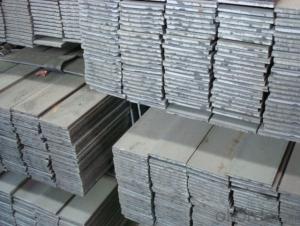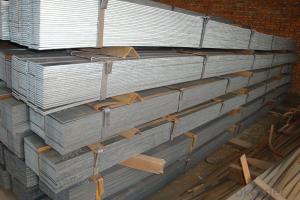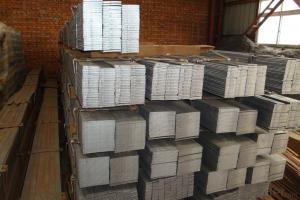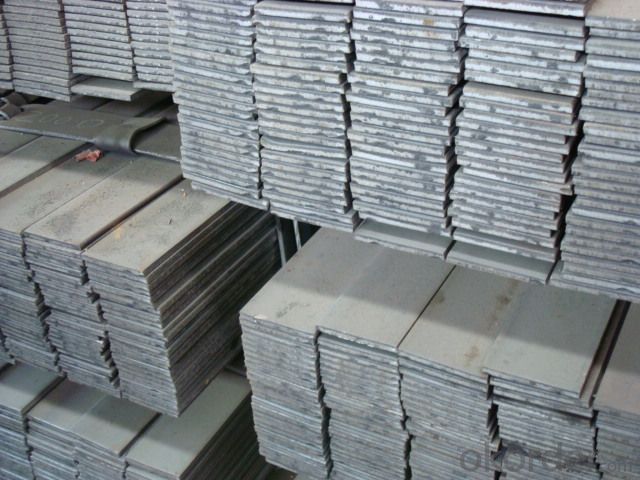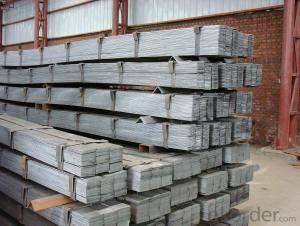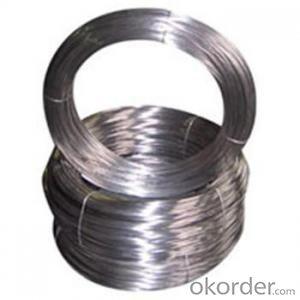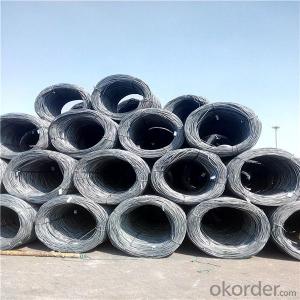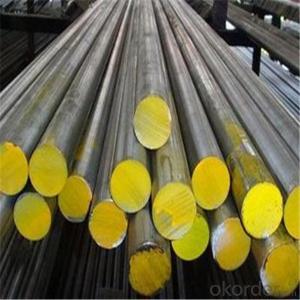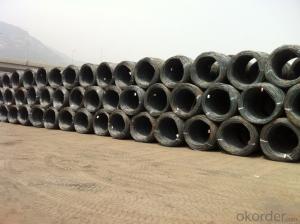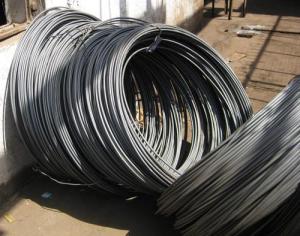Alloyed flat bar-steel
- Loading Port:
- China Main Port
- Payment Terms:
- TT OR LC
- Min Order Qty:
- -
- Supply Capability:
- -
OKorder Service Pledge
Quality Product, Order Online Tracking, Timely Delivery
OKorder Financial Service
Credit Rating, Credit Services, Credit Purchasing
You Might Also Like
Quick Details
| Place of Origin: | Brand Name: | Model Number: | |||
| Material: | white: |
Packaging & Delivery
| Packaging Detail: | the package of the wire rod steel for construction is standard exporting package |
| Delivery Detail: | 30d upon recipt of L/C |
Specifications
the wire rod steel for construction that we offer have been used in civil construction work for years.
SPECIFICATION
1: WIRE ROD IN COIL
2. STANDARD: AISI,ASTM,BS,DIN,GB,JIS
3. STEEL GRAD: Q195--235/SAE1006B/SAE1008B/SA31012B/SDA31015B/SA31018B/SA31022B
4. SIZE: 5--22MM
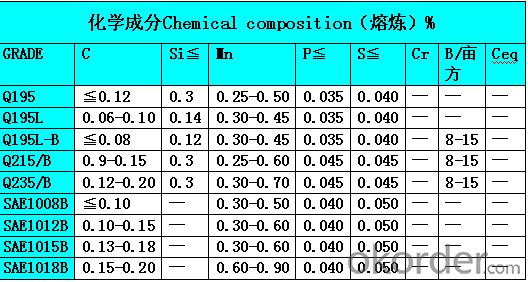
1) the products that we offer haven been used in civil constrction work for years
2) meet different requirment
3) we can offer accordingly with different demands
- Q: How is steel wire rod used in the production of wire mesh sieves?
- Wire mesh sieves require steel wire rod as an essential component. The wire rod undergoes various processes, such as drawing, annealing, and coating, to improve its strength and durability. Once prepared, the steel wire rod is fed into a wire drawing machine to reduce its diameter to the desired size. This ensures uniform thickness and a smooth surface, which is crucial for subsequent manufacturing steps. After drawing, the wire is annealed to increase flexibility and remove any residual stresses. This makes it easier to work with and less likely to break during production. Next, the wire is coated with zinc or PVC to enhance its resistance to corrosion. This protective layer acts as a barrier, prolonging the wire's lifespan and maintaining its structural integrity. The coated wire is then woven or welded to create the wire mesh sieve. Weaving involves interlacing the wires in a crisscross pattern, while welding involves fusing the wires at their intersections using heat and pressure. The resulting wire mesh sieve is a versatile and reliable tool used in various industries. It is commonly employed for particle size analysis, filtration, and sorting applications. The steel wire rod used in its production ensures it can withstand high pressures and abrasion, making it suitable for demanding environments. In conclusion, steel wire rod plays a crucial role in the manufacturing process of wire mesh sieves. It undergoes drawing, annealing, and coating before being woven or welded to create the final product. The resulting wire mesh sieve is a robust tool used in a wide range of industries for particle analysis and filtration purposes.
- Q: What are the common tensile strengths of steel wire rod?
- The common tensile strengths of steel wire rod vary depending on the specific grade and type of steel being used. However, typical tensile strengths for steel wire rod range from 500 MPa (megapascals) to 1800 MPa.
- Q: Can steel wire rod be used in the production of reinforcing bars?
- Steel wire rod has the ability to be utilized in the manufacturing of reinforcing bars, commonly referred to as rebar. These rebar are crucial for fortifying and reinforcing concrete structures, such as buildings, bridges, and highways. Steel wire rod serves as a raw material during the manufacturing process of rebar. Typically, this wire rod is composed of top-notch steel and is drawn into the desired thickness and shape to meet the specific requirements of reinforcing bars. By doing so, it furnishes the necessary strength and durability needed to enhance the structural integrity of concrete, thus preventing any potential cracking or failure. Consequently, steel wire rod stands as an essential element in the production of reinforcing bars.
- Q: How is steel wire rod used in the manufacturing of wire mesh conveyor belts?
- Steel wire rod is used in the manufacturing of wire mesh conveyor belts as it serves as the primary material for the production of wire mesh. The wire rod is drawn into thin wires, which are then woven together to form a mesh pattern. This mesh structure provides strength, flexibility, and durability to the conveyor belts, allowing them to withstand heavy loads and high temperatures commonly encountered in industrial applications. Additionally, the steel wire rod's corrosion resistance and high tensile strength make it an ideal choice for constructing conveyor belts that can efficiently transport materials in various industries such as mining, food processing, and automotive manufacturing.
- Q: What are the main steel wire rod import and export markets?
- The main steel wire rod import and export markets include countries like China, Japan, South Korea, Germany, and the United States. These countries have a significant demand for steel wire rod due to their large manufacturing industries and construction sectors. Additionally, emerging economies such as India and Brazil are also important players in the steel wire rod import and export market.
- Q: What are the different types of steel wire rod coatings used for high-temperature resistance?
- There are several types of steel wire rod coatings that are used for high-temperature resistance. These coatings are designed to protect the steel wire rod from oxidation, corrosion, and other forms of damage that can occur at elevated temperatures. One common type of coating used for high-temperature resistance is zinc. Zinc coatings provide excellent corrosion protection at high temperatures and are often used in applications where the steel wire rod will be exposed to extreme heat. Another type of coating that is commonly used for high-temperature resistance is aluminum. Aluminum coatings can withstand high temperatures and provide a barrier against oxidation and corrosion. Additionally, there are specialized coatings that are specifically designed for high-temperature resistance. These coatings often contain materials such as ceramic, refractory metals, or silicone-based compounds. Ceramic coatings, for example, are known for their ability to withstand extremely high temperatures and provide excellent thermal insulation. Refractory metal coatings, such as tungsten or molybdenum, are used in applications where the steel wire rod will be exposed to extremely high temperatures and harsh environments. Silicone-based coatings are known for their heat resistance and can provide a protective barrier against oxidation and corrosion. The choice of coating depends on the specific application and the desired level of high-temperature resistance. It is important to consider factors such as the operating temperature, the environment, and the level of protection required when selecting a coating for steel wire rod used in high-temperature applications.
- Q: What are the common industry research initiatives for steel wire rod?
- Some common industry research initiatives for steel wire rod include improving production efficiency, enhancing product quality, exploring new alloy compositions, investigating new manufacturing techniques, studying the impact of different processing parameters on wire rod properties, and researching innovative applications for steel wire rod in various industries.
- Q: How are steel wire rods used in the production of screws and bolts for construction?
- Screws and bolts for construction purposes rely heavily on steel wire rods, which serve as the essential ingredient in their production. The process begins with the steel wire rods undergoing a series of manufacturing steps. Initially, the rods are drawn through dies to reduce their diameter and increase their length, a technique known as wire drawing. This step ensures that the wire rods achieve the desired size and strength. Once the wire rods are drawn to the required dimensions, they are then cut into smaller lengths suitable for creating screws and bolts. These shorter lengths are commonly known as blanks or billets. The next stage involves threading these blanks to give them the distinctive shape of a screw or bolt. This threading process is typically executed using specialized machines that cut or roll grooves onto the surface of the wire rods. These grooves provide the necessary grip for the screws and bolts, ensuring a secure connection to the respective materials. After the threading process, the blanks undergo further processing to add various features, such as head shape, drive type, and any additional coatings or finishes required for corrosion resistance. Machining or forging processes are usually employed, depending on the desired specifications of the screws and bolts. Quality control checks are then conducted on the formed screws and bolts to verify that they meet the required standards for strength, dimensions, and overall functionality. Factors such as tensile strength, hardness, and dimensional accuracy are tested to ensure the reliability of the fasteners. The final step involves packaging and distributing the screws and bolts for use in construction projects. These fasteners play a crucial role in connecting different components of a structure, providing stability, strength, and durability to the overall construction. They find widespread use in applications such as framing, securing walls, connecting beams, and joining various building materials. In conclusion, steel wire rods serve as the fundamental raw material for the production of screws and bolts in the construction industry. They undergo a series of manufacturing processes to shape them into fasteners with specific features and properties. These fasteners are essential for the structural integrity and reliability of construction projects, making steel wire rods an indispensable component in the construction field.
- Q: What are the common types of steel used for wire rod production?
- Wire rod production utilizes a variety of steel types, including carbon steel, alloy steel, and stainless steel. Carbon steel stands as the most prevalent option, owing to its affordability and versatility. Comprised mainly of iron and carbon, it also contains trace amounts of other elements. In contrast, alloy steel merges iron with additional elements like manganese, chromium, or nickel. This type of steel boasts heightened strength, durability, and resistance to wear and tear. Conversely, stainless steel finds common use in wire rod production, particularly when corrosion resistance is imperative. With a high chromium content, it forms a protective oxide layer on the surface, preventing rust and corrosion. These diverse steel types present varying properties and characteristics, enabling manufacturers to meet specific requirements for wire rod production across different industries.
- Q: How are steel wire rods used in the production of fishing lines?
- To enhance the strength and durability of fishing lines, steel wire rods are employed. These rods act as the backbone of the line, granting it the tensile strength needed to endure the pressure and weight imposed by sizeable fish. Typically crafted from top-notch stainless steel, the steel wire rods employed in fishing lines possess resistance to rust and corrosion. This characteristic is crucial since fishing lines are consistently exposed to water and moisture, which can lead to material deterioration over time. Throughout the manufacturing process, a protective layer, such as nylon or polymer, is applied to the steel wire rods. This coating not only bolsters their performance but also renders them more suitable for fishing purposes. It not only contributes added strength but also enhances the line's flexibility, facilitating easier casting and retrieval. Additionally, the steel wire rods determine the overall diameter and weight of the fishing line. Thicker rods result in a heavier and stronger line, while thinner rods produce a lighter and more sensitive one. This enables anglers to select a fishing line that aligns with their specific requirements and fishing conditions. Moreover, the incorporation of steel wire rods into fishing lines amplifies sensitivity, enabling anglers to detect even the most subtle nibbles or movements by fish. This proves especially advantageous in situations where fish are more cautious and necessitate a delicate approach. In conclusion, steel wire rods play a critical role in the production of fishing lines. They provide the essential strength, durability, and sensitivity required, serving as the foundation of the line to withstand the weight of large fish and resist the detrimental effects of water and corrosion.
Send your message to us
Alloyed flat bar-steel
- Loading Port:
- China Main Port
- Payment Terms:
- TT OR LC
- Min Order Qty:
- -
- Supply Capability:
- -
OKorder Service Pledge
Quality Product, Order Online Tracking, Timely Delivery
OKorder Financial Service
Credit Rating, Credit Services, Credit Purchasing
Similar products
Hot products
Hot Searches
Related keywords
